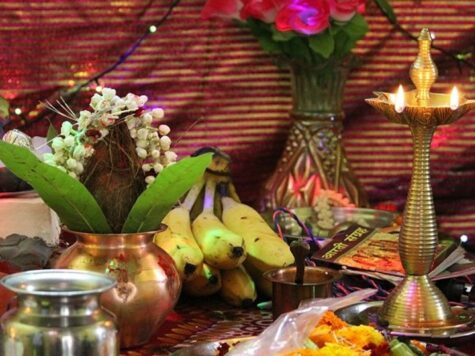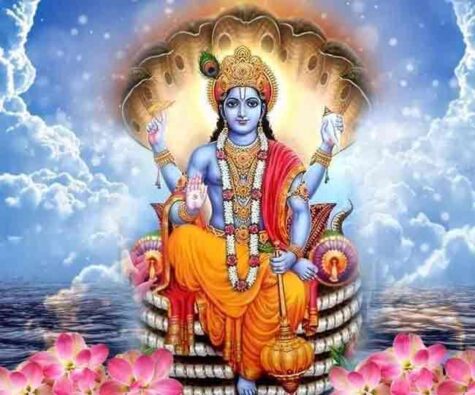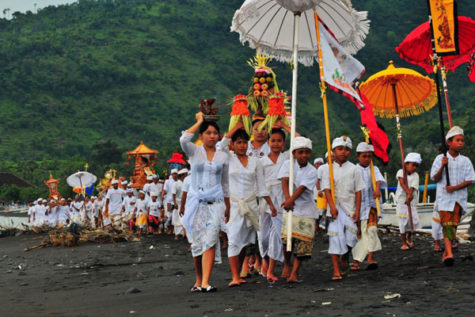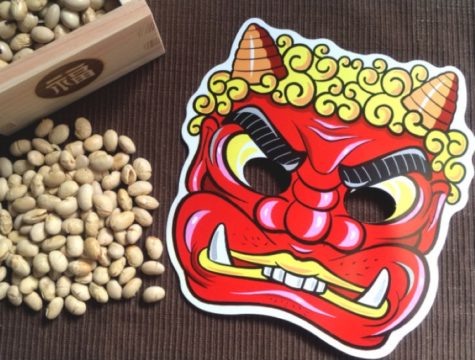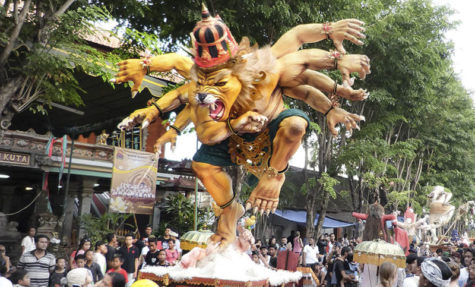Cleansing and Clearing
Ekādaśī Tithi, the eleventh lunar day (Tithi) between the New Moon and Full Moon is an important day in Hinduism and Vaishnavism tradition. Ekadashi, also spelled as Ekadasi, is a day of self purification, redemption and spiritual progress. It is also known as Hari Vasara because it is dedicated to Lord Vishnu, is a day of fasting and prayers for all Hindus.
Our current Calendar has the dates of these days listed for every month. It can be found here.
Those who fast on this day are considered to get rid of malefic planetary influences, experience happiness, and gain the right peace of mind to think of Ishvara and attain moksha. It is a day of Vishtikarana, a day of malefic influences. Vishtikarana coincides with the second half of Ekādaśī Tithi and is avoided for all functions associated with worldly prosperity.
Ekadasi occurs twice in a Lunar month, in the bright fortnight and the dark fortnight. It is recommended to do a strict fast which means not to eat and drink at all because food is filled with our sins and bad karma. On this day, taking food increases our bad fortune. but if we fast this day we “burn” bad karma and and increase good fortune.
Fasting gives the body a chance to give rest to the digest system, instead of regular heavy meals three times a day, more fruits and light food is consumed, by doing so person goes for more of a spiritual life. It also teaches better control over body and mind. One of the biggest gains is staying healthy.
It is also important to give the physiological system some rest once a while. It may be overworked due to overeating or indiscrimination in diet. These irregularities get rectified in one day. Thus the observance of Ekadasi has many advantages — physical, astral, spiritual — and because this day has connection with the relation of the mind and body together with the moon, it helps improve meditation and contemplation.
The reason is because the planet itself is in a certain state on that day, so if we keep our body light and available, our awareness will turn inward. The possibility of opening the door within is more on that day. If you have a full stomach, and you are unaware and dull, you will not notice it. So to stay alert and also to purify the body, you go without food on that day – you ate dinner the previous day and the next thing you eat is dinner on Ekadashi.
Hinduism puts forth the idea that spiritual ascesis during Ekadashi helps a person to “jump out” of life and death cycle. Ayurveda recommends fasting to improve one’s health. Follow your personal features:
- If you have “dosha kapha” – keep dry fasting.
- If you have “Vata” then drink lemon water.
- If you have “Pita” drink milk or juice (use 40% of milk and 60% of water, pour some sugar)
Depending on your state of health, work load, and other factors you can choose your personal diet taking into account the recommended food for the day.
If you are unable to go without food – because your activity levels are such and you do not have the sadhana to support you – you can go on phalahara or fruit diet, which is light on the stomach so that your inner doors will open. Forceful denial of food is not the point. The point is to make everything into a conscious process. We do not want to compulsively eat like this, we choose.
How to abide by Ekadashi
In the Ekadashi morning you should take a shower, calm down and clear your mind and body. It is important to understand that fasting is not just rejection of food or any other stuff. If you give vent to anger or moral deficiency – you are not actually keeping a fast, you are just not eating. Avoid daytime sleep, oil massage and shaving.
If you are not fasting eat no more than one time per day (after midday) during Ekadashi.
If you happen to miss the Ekadashi – you can do the fast it the next day (Dvadashi) and stop fasting on the 3rd day (Triodashi). If the Ekadashi coincides with dashas (the 10th lunar days) there’s no need to fast, buf if it coincides with the Dvadasha (12th Lunar day) it calls “pure Ekadashi” (Mahadvadashi) and it can be kept strictly.
Stop fasting the next morning 2-3 hours after the sunrise. The first meal should consist of fresh fruits or juices. Be careful with your ration. Your stomach is not working during fasting so do not overload it with heavy food when your fast is over.
It is recommended to prepare yourself for the first time fasting during the Ekadashi. Calm your mind and body. Do not overeat the day before fasting, do not take animal food. Vegetables, fruits, porridge are advisable. You can perform cleaning procedures (clyster, etc.). When you stop fasting drink juices, eat vegetables, fruits, cereals, etc. but not too much.
The Mantra For Ekadashi
The Vishnu mantra chanted on this day is:
“Om Namo Bhagavate Vasudevaya”
Hare Krishna maha-mantra to chant 108 times:
“Hare Krishna Hare Krishna
Krishna Krishna Hare Hare,
Hare Rama Hare Rama
Rama Rama Hare Hare
Or:
Hare Rama Hare Rama
Rama Rama Hare Hare,
Hare Krishna Hare Krishna
Krishna Krishna Hare Hare
Sources:
Nyepi Day in Bali is a New Year celebration unlike anywhere else on the planet. Unlike other cultures that celebrate New Year with vivacious and loud festivities, the pinnacle of Balinese New Year is a day of complete Silence. Hence the name Nyepi, meaning “to keep silent” in the local language, which falls on the day following the dark moon of the spring equinox.
It’s ultimately the quietest day of the year, when all of the island’s inhabitants abide by a set of local rules. These bring all routine activities to a complete halt. Roads all over Bali are void of any traffic and nobody steps outside of their home premises.
Nyepi is a day fully dedicated to connect oneself more closely with God (Hyang Widi Wasa) through prayers and at the same time as a day of self-introspection to decide on values, such as humanity, love, patience, kindness, and others, that should be kept forever.
The unique day of silence marks the turn of the Saka calendar of western Indian origin. It’s one among the many calendars assimilated by Indonesia’s diverse cultures. The Saka is also among two calendars that are jointly used in Bali. The Saka is 78 years behind the Gregorian calendar, and follows a lunar sequence. Nyepi follows after a new moon, and the dates vary from year to year.
Before the Silence Before ‘the silence’, highlight rituals essentially start three days prior to Nyepi, with colourful processions known as the Melasti pilgrimages. Pilgrims from various village temples all over Bali convey heirlooms on long walks towards the coastlines where elaborate purification ceremonies take place. It is one of the best times to capture on camera the iconic Balinese processions in motion, as parasols, banners and small effigies offer a cultural spectacle.
Village meeting halls known as ‘banjar’ and streets feature papier-mâché effigies called ogoh-ogoh. They are built throughout the weeks leading up to the Saka New Year. Youth groups design and build their mythical figures with intricately shaped and tied bamboo framework before many layers of artwork. These artistic creations are offshoots of the celebration. Much of it has stayed on to become an inseparable element in the island-wide celebration that’s Nyepi Eve.
Then on Saka New Year’s Eve, it is all blaring noise and merriment. Every Balinese household starts the evening with blessings at the family temple and continues with a ritual called the pengrupukan where each member participates in ‘chasing away’ malevolent forces, known as bhuta kala, from their compounds – hitting pots and pans or any other loud instruments along with a fiery bamboo torch. These ‘spirits’ are later manifested as the ogoh-ogoh to be paraded in the streets. As the street parades ensue, bamboo cannons and occasional firecrackers fill the air with flames and smoke. The Nyepi Eve parade usually starts at around 19:00 local time.
However on Nyepi Day, complete calm enshrouds the island. The Balinese Hindus follow a ritual called the Catur Brata Penyepian, roughly the ‘Four Nyepi Prohibitions’. These include:
- amati geni or ‘no fire’
- amati lelungan or ‘no travel’
- amati karya ‘no activity’
- amati lelanguan ‘no entertainment’
Some consider it a time for total relaxation and contemplation, for others, a chance for Mother Nature to ‘reboot’ herself after a year of human pestering. No lights are turned on at night – total darkness and seclusion goes along with this new moon island-wide, from 06:00 to 06:00. No motor vehicles whatsoever are allowed on the streets, except ambulances and police patrols and emergencies. Traditional community watch patrols or pecalang enforce the rules of Nyepi, patrolling the streets by day and night in shifts.
Sources:
Japan has four distinct seasons: spring, summer, autumn, and winter. The term setsubun originally referred to the days marking the change from one season to the next, so that there were four of them, but today only the day before risshun (the beginning of spring in the traditional Japanese calendar) is called by that name. Setsubun comes on either February 3 or 4, depending on the year.
On the night of Setsubun, many households do mame-maki – a bean-throwing ceremony. The toshiotoko of the household (a male born on the corresponding Chinese zodiac animal of the year), or the male head of the household, throws pan-heated soybeans out the door, while chanting:
“Oni wa soto!
Fuku wa uchi!”
“Demons out!
Luck in!”
After the mame-maki is over, everyone eats the same number of beans as their own age. It is believed that by doing so, people will be free of sickness during that year.
Mame-maki began as a New Year ceremony (in the traditional Japanese calendar) to drive out evil spirits and the seeds of misfortune, as well as to pray for the family’s well-being and good business. In the Heian era, a famous Buddhist monk was said to have driven away Oni (demons or evil spirits) by throwing beans.
Oni masks are popular. Oni are mountain ogres with horns; fangs; red, blue, brown or black skin; and carry weapons.
Families with little children especially look forward to this day because mame-maki can be a lot of fun. One person acts as the goblin and runs around, while the others throw beans at the person. At some schools, the students make goblin masks and enjoy mame-maki.
At Buddhist temples and Shinto shrines all over the country, there are celebrations. Priests and invited guests will throw roasted soy beans (some wrapped in gold or silver foil), small envelopes with money, sweets, candies, and other prizes for people to catch.
Some families put up hiiragi iwashi (holly sardine), small decorations made from cooked sardine heads (sometimes the whole fish) stuck onto holly branches. They are placed on the entrance to the home so that bad spirits may not enter.
A traditional food is Eho Maki, a sushi roll made with seven “lucky” ingredients. Though sushi rolls are usually sliced into bite-sized pieces, Eho Maki is not, as slicing it would cut off good fortune. A wish is made, then the roll is eaten in silence while facing the year’s lucky compass direction. The direction changes each year. Ginger sake is a customary drink.
From 365 Goddess:
- Themes: Luck; Protection; Cycles; Happiness
- Symbols: A Snowflake; Beans
- Color: White
- Presiding Goddess: Shirata
About Shirata:
This Japanese goddess embodies the first snow, where she glistens and shines with incomparable beauty until she freely and joyfully gives herself to spring’s warmth and melts away. By so doing, Shirata reminds us that while the year has only just begun, the wheel of time is ever moving, and that we should make the most of every moment.
To Do Today:
For happiness, cut a snowflake pattern out of a quartered piece of white paper and carry it with you in your wallet as a charm. Make sure to visualize the snowflake being filled with brilliant white light, like that which is seen when the sun shines off new-fallen snow.
In Japan, this day (Setsubun) is a time to chase away any malevolent influences that might hinder Shirata’s joyful nature within us. People scatter beans and make loud noises to banish evil and carve lanterns with wishes to light the way for a better tomorrow. For our purposes, scatter seeds on the ground or plant beans instead so something as beautiful as Shirata can replace any negativity in your life with abundant growth.
To internalize Shirata’s happiness, prepare any white beans and eat them as part of a meal today. If you hold any rituals, use beans to mark the magic circle, scattering them counterclockwise to banish any unwanted influences.
From: Web Holidays and 365 Goddess
The best days listed here are based on both the phase of the moon and its position in the zodiac. Many people believe that if you do the tasks on the dates listed, you will get the best results possible.
January
- Demolition: 2, 3, 21, 29, 30
- Paint: 7, 8, 14, 15, 20, 21
- Wash Windows:2, 3, 29, 30
- Wash Wooden Floors: 2, 3, 21, 29, 30
- Wax Floors: 5, 6, 9 – 11, 14, 15, 18, 19
February
- Demolition: 25 – 27
- Paint: 3, 4, 10 – 12, 17, 18
- Wash Windows: 25 – 27
- Wash Wooden Floors: 3, 25 – 27
- Wax Floors: 5 – 7, 10 – 12, 15, 16
March
- Demolition: 25, 26
- Paint: 2– 4, 10, 11, 16, 17, 29 – 31
- Wash Windows: 25, 26
- Wash Wooden Floors: 2 – 4, 25, 26, 29 – 31
- Wax Floors: 6, 10, 11, 14, 15, 18, 19
April
- Demolition: 3, 4, 21, 22
- Paint: 6, 7, 13, 14, 26, 27
- Wash Windows: 21, 22
- Wash Wooden Floors: 3, 4, 21, 22, 26, 27
- Wax Floors: 6, 10, 11, 14, 15, 18, 19
May
- Demolition: 1, 2, 18 – 20, 28 – 30
- Paint: 3, 4, 10, 11, 23 – 25, 31
- Wash Windows: 18 – 20
- Wash Wooden Floors: 1, 2, 18 – 20, 23 – 25, 28 – 30
- Wax Floors: 4, 8, 9, 12 – 17
June
- Demolition: 24 – 26
- Paint: 1, 6, 7, 19 – 21, 27, 28
- Wash Windows: 15, 16
- Wash Wooden Floors: 2, 19 – 21, 24 – 26, 29, 30
- Wax Floors: 4, 5, 8 – 14
July
- Demolition: 22, 23
- Paint: 3 – 5, 17, 18, 24 – 26, 31
- Wash Windows: 12, 13
- Wash Wooden Floors: 17, 18, 22, 23, 27, 28
- Wax Floors: 2, 6 – 11, 14, 15
August
- Demolition: 18 – 20, 27, 28
- Paint: 1, 13, 14, 21, 22, 27, 28
- Wash Windows: 8 – 10
- Wash Wooden Floors: 18 – 20, 23, 24, 27, 28
- Wax Floors: 2 – 7, 11, 12, 30, 31
September
- Demolition: 14 – 16, 24, 25
- Paint: 9 – 11, 17, 18, 24, 25
- Wash Windows: 4 – 6
- Wash Wooden Floors: 14 – 16, 19 – 21, 24, 25
- Wax Floors: 1 – 3, 7, 8, 12, 13, 28 – 30
October
- Demolition: 13, 21, 22
- Paint: 6 – 8, 14, 15, 21, 22
- Wash Windows: 2, 3, 29, 30
- Wash Wooden Floors: 13, 16 – 18, 21, 22
- Wax Floors: 1, 4, 5, 9 – 11, 27, 28, 31
November
- Demolition: 17, 18
- Paint: 3, 4, 10 – 12, 17, 18, 30
- Wash Windows: 26, 27
- Wash Wooden Floors: 13, 14, 17, 18
- Wax Floors: 1, 2, 5 – 7, 10, 11, 28, 29
December
- Demolition: 14 – 16, 23, 24
- Paint: 1, 2, 8, 9, 14 – 16, 28, 29
- Wash Windows: 23, 24
- Wash Wooden Floors: 14 – 16, 23, 24
- Wax Floors: 3, 4, 8, 9, 26, 27, 30, 31
Source: The Farmer’s Almanac
Burning the Devil or La Quema del Diablo is a tradition held every December 7, at 6:00 in the evening sharp, families build bonfires outside their homes and burn effigy of Satan. It is a tradition that many Guatemalans take part as a way to cleanse their home from devils that lurk in their home, creeping behind the furniture or hiding under the bed.
La quema del diablo can be traced to colonial time, a tradition that started since the 18th century. Held on the eve of the Feast of the Immaculate Conception and as a prelude to holiday season, those who could afford it adorns the fronts of their houses with lanterns, but for those who have lesser means builds a bonfires from their trash to celebrate the occasion.
A symbolical tradition with a belief that the fire burns the devil serves as purifying element, as the Virgin Mary was the blessed one to conceive baby Jesus must be free from any form of evil, therefore the event serves as “burning the devil” to clear the way for Mary’s feast.
Though the celebration may sound fun, it is controversial especially for the environmentalist groups. Back in the days, mostly paper were burned for the “cleansing ritual”, but now, piles of rubbish are mostly made of plastic and rubber that causes air pollution.
Over time the tradition evolved, from burning piles of garbage and pieces of furniture to being replaced by the effigy of Satan in a form of piñatas.
The tradition has special significance in Guatemala City because of its anticipation of Feast of the Immaculate Conception, the patron saint of the city. Along the street of Zona 1, the historic city center, many vendors pile the street selling stuffs associated with La Quema del Diablo, from firecrackers to simple and intricate devil piñatas. In different parts of the city, people celebrate and burn their own devil piñatas.
The tradition continues, as the idea is to burn all the bad from the previous year and to start anew from the ashes. It is widely observed throughout the country, The Devil is burned at the stroke of six. In Antigua, the former capital of the country, a devil three stories tall is constructed and burned in the city square.
A variation of this tradition is held in San Antonio Palopo. In this very unique celebration, they carry a statue of Maximón around town with a noose around his neck, they locals then hang Maximón by his neck in front of Catholic church, douse him with gasoline, and set him on fire. This is the local way of showing respect to the Christian god.
Setting people on fire has been a way of ridding the town of evil doers for many centuries. As soon as the Spaniards settled in Guatemala they brought with them the Christian religion. The Christian religion frowned on bloodshed. So instead they burned evil doers alive to kill them. This way they did not shed blood and therefor committed no sin.
Most of the inhabitants still pray to both the Christian and Mayan gods and deities such as Maximón or ancestors. They often ask for healing, wealth, help with love and sexual fertility.
The locals say they pray to both just in case one god does not grant their wishes the other might. This happens with both evangelical and Catholic believers. ( Not all, but the majority) This is kept secret for fear of discrimination from others.
While the many of the locals pray to both god and deities they publicly denounce Maximón shortly before Christmas by dragging him around the village then hang him with a noose and set him on fire.
The political version of this festival:
Guatemalans burn traditional devil puppets to start their Christmas celebrations. The ceremonial burning of devils started in the 16th century and is meant to chase away bad spirits. And in 2016, US president-elect Donald Trump was a big hit. But not in a good way.
Revelers in Guatemala set ablaze cardboard piñata of Trump wearing devil horns. In fact, piñata makers said Trump is far and away the best-seller. Trump’s hardline stance on immigration during his election campaign, including a promise to build a wall along the US-Mexico border, has drawn anger from Latin Americans in the US and around the world.
So this is a way to vent out the anger? It can be. Guatemalans believe the practice of torching the devil helps banish bad spirits from their homes and neighborhoods.
Sources:
According to various sources, February 26 is Hygeia’s Day. I did not, however, find any specific rituals associated with the Goddess Hygeia. However, because bathing is so fundamental to basic hygeine, and Hygeia is the goddess of Healing and Hygeine, a healing ritual bath seems appropriate.
Healing Ritual Bath
Take a lit silver or white candle, some salt, and a healing oil (such as carnation, violet, sandalwood, or narcissus) into the bathroom. By the candle’s light run a tub of very warm water. Cast some salt into it, add a few drops of healing oil, and then step into the tub.
Relax. Feel the warm salted water sinking into your pores, through your skin, sterilizing the sick or unhappy portions of your body.
Visualize any illness or bad feelings as “black worms” leaving your body. When you feel the water teeming with them, pull the plug and let the water drain out. While it is draining, chant:
The sickness is flowing out of me.
Into the water, down to the sea.
Only when the tub is completely drained stand up. It is best to immediately splash your body with fresh water (a shower is ideal) to remove the last vestiges of the disease of sickness-laden water. Repeat as needed to speed your body’s recovery.
From: Earth Power
Februalia, Februa, and also Februatio, was the Roman festival of ritual purification, later incorporated into Lupercalia. The festival, which is basically one of Spring washing or cleaning (associated also with the raininess of this time of year) is old, and possibly of Sabine origin. According to Ovid, Februare as a Latin word which refers to means of purification (particularly with washing or water) derives from an earlier Etruscan word referring to purging.
The Roman month Februarius (“of Februa,” whence the English February) is named for the Februa/Februatio festival, which occurred on the 15th day of the Roman month. A later Roman god Februus personified both the month and also purification, and is named for them. Thus, the month is named for the festival and not for the god.
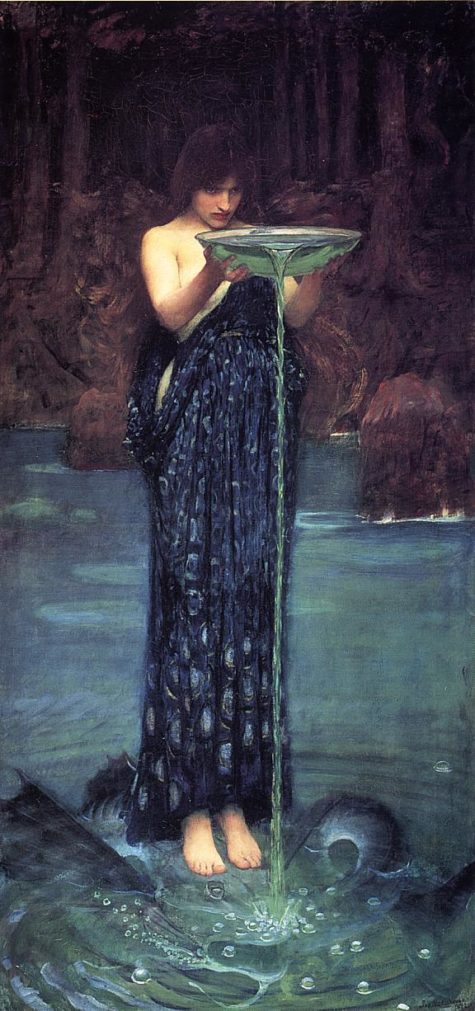
Here is a ritual for Februata, and is appropriate any day during the month of February:
- Color: White
- Element: Earth
- Altar: Spread with a clean white cloth and place thereupon four white candles and a bowl of water, very simply.
- Offerings: Clean something externally, and at the same time clean something internally.
- Daily Meal: Fasting for the day. Drink plenty of water.
Februata Invocation
The winter has lain heavily upon us,
Juno Februata, Queen of the new light,
And we are sunk in layers of thought
Like a hibernating mole
Beneath layers of earth.
Bring us forth into the light, Lady!
Let us remove all filth
From our bodies and our souls,
Making them a place of clarity.
Chant:
Februus Februus Lucina Lucina
(There is no further ritual; all silently take cleaning tools and being to thoroughly clean the entire building, ending with a ritual bath. As each cleans, they should meditate on what part of the mind or spirit needs cleansing, and let the physical cleansing aid in the spiritual aspect.)
Sources: Wikipedia and Pagan Book of Hours
The Anant Chaturdashi involves praying and seeking the favor of Lord Vishnu by worshipping an image or idol of him reclining on the serpent Sheshnaga (a mythical creature).
The festival of Anant Chaturdashi is a festival of purification celebrated by Jain and Hindus. Because this festival falls on the fourteenth day of the waxing moon period, the dates of the festival vary from year to year. In 2018, the Anant Chaturdashi will fall on September 23rd.
There are important items that are required when worshiping Lord Vishnu. These are: flowers, oil lamps, incense sticks, a paste of sandalwood, vermilion and turmeric. Once these items have been availed, the worshipers can then offer milk, fruits and sweets to the eternal Lord Vishnu.
In parts of Bihar and Eastern UP, the festival is closely linked to Ocean of Milk (kshirsagar) and Lord Vishnu’s Anant Roopa. The ritual is as follows:
Fourteen tilaks (small vertical strips) of vermilion are made on a wooden plank. Fourteen puri (fried wheat bread) and fourteen pua (deep fried sweet wheat bread) are placed on these vermilion strips. A bowl containing Panchamrit (made of Milk, Curd, Jaggery, Honey and Ghee) symbolizing kshirsagar (Ocean of Milk) is placed on this wooden plank.
A thread having fourteen knots, symbolizing Lord Anant is wrapped on a cucumber and is swirled five times in this “Ocean of Milk”. Later this Anant thread is tied on the right arm above the elbow by men. Women tie this on their left arm.
Anant’s Vow
A thread colored with turmeric and kumkum, knotted in 14 different places and considered sacred by Hindus/Jains is worn on the right and left wrists of men and women respectively. This Anant thread is removed after fourteen days. It is a visible sign of the vow that is being made on this day, and the following words are chanted by the worshipers while wearing this thread known as Anant Sutra:
“Ananta Sansar Maha Samudre Magnan Samabhyuddhar Vasudeva Ananta Rupey Viniyojitatmamahya Ananta Rupey Namoh Namastute.”
The women of the family fast on this auspicious day while the men make a vow. This vow is to be kept for 14 years, in the hope of gaining wealth, protection and knowledge from Vishnu. Some men also make this vow so as to regain lost wealth.
Worshipers and devotees of the festival wake up at dawn, take a bath and engage in the puja after which they can partake of the milk and fruits. The only caveat is that they have to avoid taking salt during this period.
Lord Ganesha Departs
One may note that Chaturthi is the fourth day of the lunar fortnight, while Chaturdashi is the fourteenth. In the normal course, Anant Chaturdashi falls 12 days after Ganesh Chaturthi.
Anant Chaturdashi is also the last day of the Hindu festival of Ganeshotsav. It is generally the tenth or eleventh day after Ganesh Chaturthi, and all the Ganesh idols brought into homes and communities are immersed in the sea or nearby lakes and rivers.
On this day, people travel to the waterfront with the idols, large and small, dancing and singing in large processions. Lord Ganesha is departed, only to be welcomed the next year with equal excitement.
The story behind this festival:
There was a Brahmin named Sumant. From his wife Diksha he had a daughter named Sushila. After the death of Diksha Sumant married Karkash, who began to give a lot of trouble to Sushila. Sushila married Kaundinya, and both decided to leave the house to avoid the harassment of the step-mother. On the way they stopped near a river.
Kaundinya went to take bath, and Sushila joined a group of women who were performing worship. They told Sushila that they were worshipping “Anant”. “What kind of worship is this?” Sushila asked. “Anant’s Vow”
They told her that it was Anant’s vow. Then they explained to her the importance of that vow. Some fried “Gharga” (made of flour) and “anarase” (special food) are prepared. Half of them have to be given to the Brahmins. A hooded snake (cobra) made of “darbha” (sacred grass) is put in a bamboo basket. Then the snake (“shesh”) is worshipped with scented flowers, oil lamp and incense sticks. Food is offered to the snake and a silk string is kept before the god, and tied to the wrist. This string is called “anant”, it has 14 knots, and is coloured with “Kunkum”. Women tie the “anant” on their left hand and men on their right. The purpose of this vow is to obtain divinity and wealth, and is kept for 14 years.
After listening to this explanation Sushila decided to take the Anant vow. From that day she and her husband Kaundinya began to prosper and became very rich.
One day Kaundinya, noticed the Anant string on Sushila’s left hand. When he heard the story of the Anant vow, he was displeased and maintained that they had become rich, not because of any power of Anant, but because of the wisdom he had acquired by his own efforts. A heated argument followed, and at the end Kaundinya took the Anant string from Sushila’s hand and threw it into the fire.
After this all sorts of calamities happened in their life, and finally they were reduced to extreme poverty. Kaundinya understood that it was the punishment for having dishonoured “Anant”, and decided that he would undergo rigorous penance until God Himself appeared to him.
Kaundinya went into the forest. There he saw a tree full of mangoes, but no one was eating the mangoes. The entire tree was attacked by worms. He asked the tree if he had seen Anant, but got a negative reply. Then Kaundinya saw a cow with her calf, then a bull standing on a field of grass without eating the grass. Then he saw two big lakes joined to each other with their waters mixing with one another. Further he saw a donkey and an elephant. To every one Kaundinya asked about Anant, but no one had even heard this name. Then he became desperate and prepared a rope to hang himself.
Then suddenly an old venerable Brahmin appeared before him. He removed the rope from Kaundinya’s neck and led him into a cave. At first it was very dark. But then a bright light appeared and they reached a big palace. A great assembly of men and women had gathered. The old Brahmin went straight towards the throne.
Then Kaundinya could no longer see the Brahmin, but only Vishnu instead. Kaundinya realized that Vishnu himself had come to save him, and that Vishnu was Anant, the Eternal One. He confessed his sin in failing to recognize the Eternal in the string on Sushila’s hand. Anant promised Kaundinya that if he made the 14-year-vow, he would be free from all his sins, and would obtain wealth, children and happiness.
Anant explained that the mango tree was a Brahmin, who in a previous life had acquired plenty of knowledge, but had not communicated it to anyone. The cow was the earth, which at the beginning had eaten all the seeds of plants. The bull was religion itself. Now he was standing on a field of green grass. The two Lakes were two sisters who loved each other very much, but all their alms were spent on each other only. The donkey was cruelty and anger. Finally the elephant Kaundinya’s pride.
From: Wikipedia and World Religion News
The New Year represents a new beginning in every way. Clearing up unfinished business, of whatever kind, is a good notion, and blowing away the cobwebs from the old year that has passed is no bad thing either. In parts of Scotland this was accomplished by the juniper and water rite.
After sunset on New Year’s Eve, people went out to gather branches of juniper and buckets of fresh water from a well or stream. The branches were then placed by the fire to dry out. In the morning the head of the household took a first drink of the water and then went around the house sprinkling everyone with a few drops.
This done, all doors and windows were closed tight and the branches of dried juniper were set alight and taken through the house until everything was thoroughly fumigated. This almost certainly dates back to a very old rite in which the sacred juniper was burned at fireplaces to ensure the gifts of the New Year were properly celebrated.
We can still do this today, since there are numerous kinds of incense made from juniper, or if we are adventurous enough we can make our own. Taken through the house this leaves a pleasant aroma and gives us a sense of new beginnings.
From The Silver Bough we have this nice little New Year’s Eve folk tradition::
The house received a mini spring-cleaning. Slops and ashes, which are usually removed in the morning, are carried out. Debts must be paid, borrowed articles returned, stockings darned, tears mended, clocks wound up, musical instruments tuned, pictures hung straight; brass and silver must be glittering; fresh linen must be put on the beds. Even in the slummiest houses… brooms and pails, soap, polishing rags and darning-needles emerge from neglected cupboards and drawers, and the bairns receive a thorough scrubbing in honor of the New Year.
In Bali, the last day their 210 day Saka calendar marks the Balinese feast of purification. This is the time of the year when the lord of hell cleans out his underworld lair, and all manner of demons and evil spirits are left to roam Bali free.
During this time….when evil is afoot……the natives go to elaborate lengths to purify both their individual homes as well as the island. No corner or stone is left untouched as rites of purification and spells for protection are recounted
On this Saka New Year’s Eve, it is all blaring noise and merriment. Every Balinese household starts the evening with blessings at the family temple and continues with a ritual called the pengrupukan where each member participates in ‘chasing away’ malevolent forces, known as bhuta kala, from their compounds – hitting pots and pans or any other loud instruments along with a fiery bamboo torch.
These ‘spirits’ are later manifested as the ogoh–ogoh to be paraded in the streets. As the street parades ensue, bamboo cannons and occasional firecrackers fill the air with flames and smoke. The Nyepi Eve parade usually starts at around 19:00 local time.
This date varies from year to year, in 2019, it falls on March 6. It is based on the Saka calendar of western Indian origin, one among the many calendars assimilated by Indonesia’s diverse cultures. The Saka is 78 years behind the Gregorian calendar, and follows a lunar sequence.
If you’d like to honor this tradition, here is a simple house cleansing ritual:
You will need a broom, some sea water, or rain water with some sea salt dissolved in it, and an Asperger (optional). Open all the windows and doors in your house and starting from the center sweep the whole house. Move Deosil (clockwise) as much as possible. As you go, visualize all negativity as a wispy grey cloud which you are driving out through the windows and doors.
Now take your salt water (and Asperger if you have one) and sprinkle the salt water around the boundaries of your whole home, making sure that you include the sills of all the doors and windows. Be very careful not to make everything too wet, or to sprinkle any electrical equipment, switches or sockets, etc.
As you do each door or window say: “I mark this boundary that no negativity be allowed to enter here. Blessed be.” and then close it.
If the weather is really inclement you may need to work room by room rather than doing the whole house in one go. In this case make sure you cover the boundaries between rooms and any passageways, stairs, etc. without windows.
Note: This house cleansing ritual can be used at any time.
Whenever you move into a new home it is as well to cleanse it to remove any residual negative energies which may have been left behind by the previous occupants. You may also like to do this after any period of upset in your home to thoroughly drive out the problem, or if you have been visited by someone who seems to have left some of their negativity behind them.
Sources:

